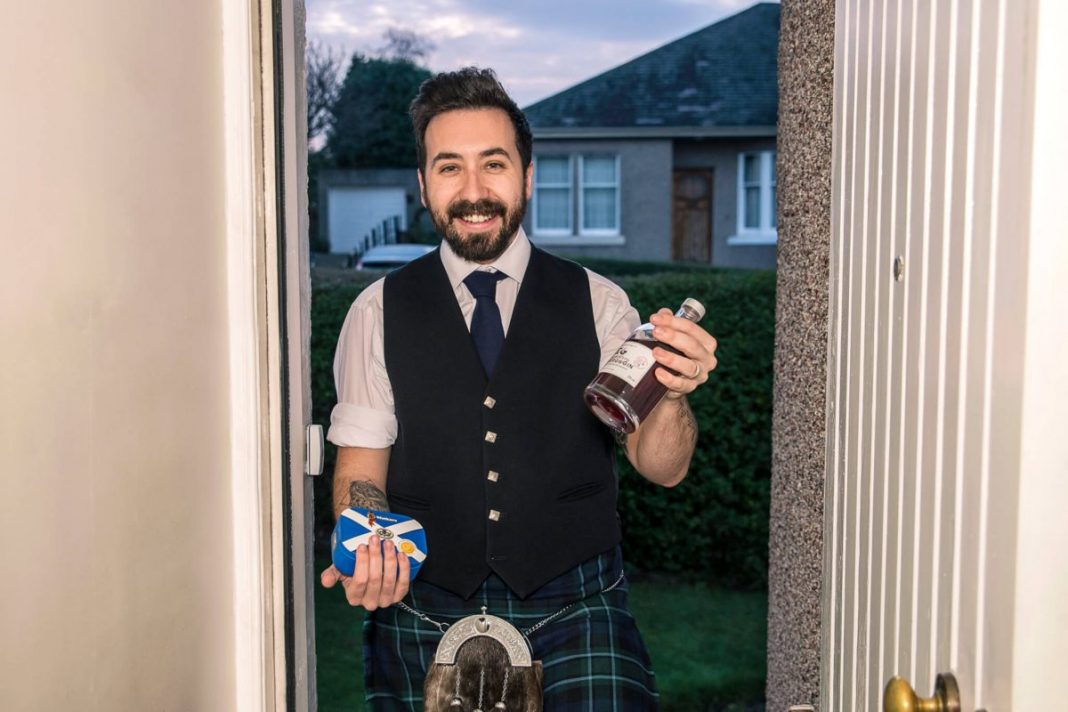In British and Manx folklore, the first-foot is the first person to enter the home of a household on New Year’s Day and is seen as a bringer of good fortune for the coming year. Similar practices are also found in Greek and Georgian new year traditions.
The origins of first-footing is uncertain, although there may be a connection to the Viking Invasion of the British Isles: “This may go back to the time of Vikings when the arrival of a blond stranger at your door would be the cause of fear and alarm.” Whenever a public ritual is suppressed many continue it at another date.
Many customs of first-footing (bringing coal, knocking on doors, group singing Auld Lang Syne to pass from the old to the new) parallel those of Samhain, the Celtic new year, for which fuel was gathered, food collected by reciting verses door-to-door, and a ritual fire lit to welcome crossing the threshold to the next world. The tradition of first-footing and how it is conducted varies from place to place in the North of England. Generally, a tall, dark-haired male is preferred over a man with light hair or even a woman.

.jpg) There are regional variations about the hair colour of the first-foot, although generally they must be a male. In East Yorkshire, the first-footer should be dark-haired, but the North York Moors first-footers should be fair-haired.
There are regional variations about the hair colour of the first-foot, although generally they must be a male. In East Yorkshire, the first-footer should be dark-haired, but the North York Moors first-footers should be fair-haired.Often it is expected that they will bring symbolic gifts, and be given food and drink in return by the inhabitants of the house they visit: The first-foot doesn’t enter the house empty-handed – any first-footers who do arrive empty-handed will bring bad luck with them. Instead, the first-foot should bring a selection of gifts for the household, which can include; a silver coin; shortbread or a black bun; salt; coal; and a drink, usually whisky.
.jpg)

They represent prosperity, food, flavour, warmth for the house, and good cheer – the whisky is used to toast the new year. The practice of first-footing is still common across Scotland and varies from place to place as part of Hogmanay celebrations. The luck that the first-foot brings with him will determine the luck for the household for the rest of the year. Generally, the first-foot should be a tall dark-haired male who is not already in the house when midnight strikes. In many areas, the first-foot should bring a selection of gifts for the household, which can include; a silver coin; shortbread or a black bun; salt; coal; and a drink, usually whisky.
They represent prosperity, food, flavour, warmth for the house, and good cheer – the whisky is used to toast the new year. The practice of first-footing is still common across Scotland and varies from place to place as part of Hogmanay celebrations. The luck that the first-foot brings with him will determine the luck for the household for the rest of the year. Generally, the first-foot should be a tall dark-haired male who is not already in the house when midnight strikes.
In many areas, the first-foot should bring with him symbolic gifts such as coal, coins, whisky, or black buns. Food and drink will be given to the first-foot and any other guests. Often women and light or red haired men are considered very unlucky. In Scotland, first-footing has traditionally been more elaborate than in England, involving subsequent entertainment.















